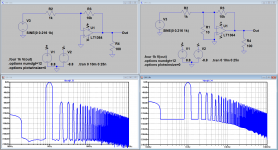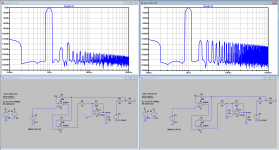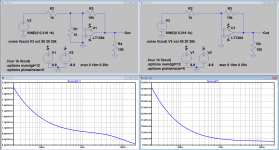If the Sequerra guy responds to my email I'll try to use him. It's been 2 days so my faith is waning in that.Or you find a trusted expert and have him sign an NDA. Then discuss your idea.
Jan
If not I'll just need to find some sort of respectable individual or lab that will do the blackbox tests you suggest. Does anyone know of a potential suggestion?
Last edited:
If the Sequerra guy responds to my email I'll try to use him. It's been 2 days so my faith is waning in that.
If not I'll just need to find some sort of respectable individual or lab that will do the blackbox tests you suggest. Does anyone know of a potential suggestion?
He might be away for a few days or whatever. Just because you can't wait for a response doesn't mean it is an emergency for Dick, right?
Did you tell him you were referred by Scott Wurcer? Did you tell him nobody knows if you are on to something or not, including you. On the remote chance you might be, you would like to have someone who know's what he is doing take a look and either tell you what you have wrong, or confirm its good?
Actually, it might be better to ask with a phone call. Email may be better to advise him you will be calling to ask about setting up a convenient time to talk in-person.
@Hellokitty,
In an attempt to structure the discussion a bit, I have made two sets of simulations. The first set is with the LT1364 in the configuration as shown by you, resp. without and with a 10 Ohm resistor between both inputs to increase the noise gain and thus distortion by a factor 100. As can be seen in my simulation, distortion goes up by 40dB as expected. For some reason the images shown by you go up only by 30dB, you probably have done something wrong.
In the second set of simulations, I have included an EC mechanism with two AD844, just because I had that sim model available. But I could just as well have selected another more modern high speed amp. And again I simulated without and with the 10 Ohm resistor between both inputs. What can be seen is that the harmonics in the 10 Ohm version to the right are going down by some 80dB because of the EC. However the left version shows a different behaviour, especially for the third harmonic, going only down by 60dB and not with 80dB.
This is to show that you simply cannot say that when in a bad situation with lots of distortion, THD goes down by 80dB, that in all situations THD goes down by 80dB. The claim that your EC reduces THD by 140dB in a situation with very high distortion, does therefore not at all imply that also in a very low distortion situation THD goes further down by 140dB.
The other thing that I have shown, is that it must be relatively easy to get a -150dB THD amplifier, when starting with a good AMP having THD in the ppm range when using a proper EC circuit.
Hans
In an attempt to structure the discussion a bit, I have made two sets of simulations. The first set is with the LT1364 in the configuration as shown by you, resp. without and with a 10 Ohm resistor between both inputs to increase the noise gain and thus distortion by a factor 100. As can be seen in my simulation, distortion goes up by 40dB as expected. For some reason the images shown by you go up only by 30dB, you probably have done something wrong.
In the second set of simulations, I have included an EC mechanism with two AD844, just because I had that sim model available. But I could just as well have selected another more modern high speed amp. And again I simulated without and with the 10 Ohm resistor between both inputs. What can be seen is that the harmonics in the 10 Ohm version to the right are going down by some 80dB because of the EC. However the left version shows a different behaviour, especially for the third harmonic, going only down by 60dB and not with 80dB.
This is to show that you simply cannot say that when in a bad situation with lots of distortion, THD goes down by 80dB, that in all situations THD goes down by 80dB. The claim that your EC reduces THD by 140dB in a situation with very high distortion, does therefore not at all imply that also in a very low distortion situation THD goes further down by 140dB.
The other thing that I have shown, is that it must be relatively easy to get a -150dB THD amplifier, when starting with a good AMP having THD in the ppm range when using a proper EC circuit.
Hans
Attachments
Last edited:
He might be away for a few days or whatever. Just because you can't wait for a response doesn't mean it is an emergency for Dick, right?
Did you tell him you were referred by Scott Wurcer? Did you tell him nobody knows if you are on to something or not, including you. On the remote chance you might be, you would like to have someone who know's what he is doing take a look and either tell you what you have wrong, or confirm its good?
Actually, it might be better to ask with a phone call. Email may be better to advise him you will be calling to ask about setting up a convenient time to talk in-person.
I have no problem waiting, I suspected the probability that he is away. From a statistics standpoint my experience is that if people don't answer within the first few days they usually won't though. He runs a business so I'll give it a couple of weeks before I decide to move on to other potential options. I like to brainstorm things in advance though. I did mention that Scott sent me. Basically what I told him is that I have a circuit I can't measure, I gave him some context and some pictures and asked him if he could help me figure it out.
He might be away for a few days or whatever. Just because you can't wait for a response doesn't mean it is an emergency for Dick, right?
Dick is at or over 90 you need patience.
This thread has been scratching me the wrong way from the beginning; besides the actual Physics involved I see a basic conceptual error.This is to show that you simply cannot say that when in a bad situation with lots of distortion, THD goes down by 80dB, that in all situations THD goes down by 80dB. The claim that your EC reduces THD by 140dB in a situation with very high distortion, does therefore not at all imply that also in a very low distortion situation THD goes further down by 140dB.
Didn´t want to knock the ball out of the field, but now that somebody else mentioned it:
I will explain what I see here using an analogy:
* Joe is tempering a bar of steel.
* he heats it up to 1200C , then quenches it in oil.
Temperature drops to 200C so he went down by 1000C
Final steel temperature then is 200C
So it´s legitimate to say: "oil lowers temperature by 1000C"
then
* he reheats the bar up to 1200C , same as before, then quenches it in water.
Temperature drops to 100C so he went down by 1100C
Final steel temperature then is 100C
So it´s legitimate to say: "water lowers temperature by 1100C"
then he has a bright idea: "mmmmhhhh, oil drops temperature by 1000C, water by 1100C ... interesting ... I think I am up to something here ....."
* he reheats the bar up to 1200C , then quenches it in oil.
Temperature drops to 200C so it went down by 1000C
Final steel temperature then is 200C
1 minute later he puts that bar in water ... temperature "should" be 200C-1100C=-900C ... shouldn´t it? ... because "water lowers temperature by 1100C"
To perceive it better, that´s -627Kelvin 😱
He´s baffled when everybody tells him "there must be something wrong with your Logic" although all sections of the experiment have been tested on their own and work fine.
Then why wouldn´t they work together?
Why wouldn´t a "140dB reducer circuit turn -150dB into -290dB?"
Unless, maybe, there is some fallacy in the reasoning.
That analogy doesn't work. It relies upon two methods of reducing the temperature. (distortion) Mine only has one. A better analogy would be he heats the bar up to 1200C and then he drops it into water which reduces the temperature to a point below that which his sensor can display (let's say it's broken). So he then raises the temperature of the bar to 2000C instead in order to attempt to see how much the water reduced the temperature without going beneath the sensors lower limit.
If you meant that the water and oil are references to various sophistication levels of my circuit then as I've stated before all tests I've done have revealed a static improvement under any circumstance, even when the DM was working. In that scenario we could say that the "steel bar" only sees a reduction in the amount of cooling that the water provides after applying the oil at a specific defined temperature. Which makes no sense or at the least is unlikely and needs further looking into.
If you meant that the water and oil are references to various sophistication levels of my circuit then as I've stated before all tests I've done have revealed a static improvement under any circumstance, even when the DM was working. In that scenario we could say that the "steel bar" only sees a reduction in the amount of cooling that the water provides after applying the oil at a specific defined temperature. Which makes no sense or at the least is unlikely and needs further looking into.
Last edited:
Let's try another one.
Driving my car at 65 Mph, I noticed that pushing the brake pedal some time and force, the speed drops to 45Mph.
So, if I drive at 15Mph and brake the very same exact way, my speed will drop and send me backward at 5Mph.
Driving my car at 65 Mph, I noticed that pushing the brake pedal some time and force, the speed drops to 45Mph.
So, if I drive at 15Mph and brake the very same exact way, my speed will drop and send me backward at 5Mph.
Adding backward direction has no direct analogical relevance. If you used the brake the same way at 15Mph then I would imagine you would slow down at the same rate as you would at 65Mph, which would make you hit the the 0Mph (noise floor) point sooner than you would at 65Mph. The analogy still agrees with me.
Of course in the real world my test could have frequency dependent variations in performance when being used at different distortion levels, even though I've never seen this to a point where it would practically matter. Certainly not the 20db difference Hans produced in sim, that's extreme. I'm thinking maybe a few of DB difference at most. The average performance increase has always remained pretty constant across harmonics. More testing is needed.
Of course in the real world my test could have frequency dependent variations in performance when being used at different distortion levels, even though I've never seen this to a point where it would practically matter. Certainly not the 20db difference Hans produced in sim, that's extreme. I'm thinking maybe a few of DB difference at most. The average performance increase has always remained pretty constant across harmonics. More testing is needed.
Last edited:
Direct measurement is needed.
Results based on reasonings ask for serious analysis and accurate protocols.
If not reproducible, by other labs, it has no value.
With a hidden part, I see no way you can prove anything. Not in the scientific realm. You are wasting your time.
Results based on reasonings ask for serious analysis and accurate protocols.
If not reproducible, by other labs, it has no value.
With a hidden part, I see no way you can prove anything. Not in the scientific realm. You are wasting your time.
By the way, at least for a plain old feedback amplifier, the noise gain method only increases the distortion of the active part, not of the passive components in the feedback network. That's easy to see by a thought experiment.
Suppose you had an ideal op-amp with a feedback network consisting of resistors that distort a bit. All distortion will then be due to these resistors.
Now connect some small but nonzero noiseless resistor between the inputs of the ideal op- amp. As the voltage between the inputs of an ideal op-amp is zero by definition, there will be no current flowing through the extra resistor and it will have no influence at all.
This may be an advantage when you want to measure the op-amp's distortion, but it causes wrong results when you want to use the noise gain method to measure the distortion of the whole amplifier.
Suppose you had an ideal op-amp with a feedback network consisting of resistors that distort a bit. All distortion will then be due to these resistors.
Now connect some small but nonzero noiseless resistor between the inputs of the ideal op- amp. As the voltage between the inputs of an ideal op-amp is zero by definition, there will be no current flowing through the extra resistor and it will have no influence at all.
This may be an advantage when you want to measure the op-amp's distortion, but it causes wrong results when you want to use the noise gain method to measure the distortion of the whole amplifier.
I think that is flawed Marcel. The input of the opamp is not zero by definition - rather, it is, by definition, Vout/Aol. There must be some input to support the output. That means that the noise and non-linearity of that 10 ohms is also amplified, with the noise gain in this case.
Jan
Jan
@hellokitty
For both versions with and without the 10 Ohm resistor between the inputs, I have plotted the noise spectrum referred to the input.
It would be instructive if you could simulate and show us the noise spectrum for both versions, but now including your EC.
Hans
For both versions with and without the 10 Ohm resistor between the inputs, I have plotted the noise spectrum referred to the input.
It would be instructive if you could simulate and show us the noise spectrum for both versions, but now including your EC.
Hans
Attachments
A better analogy is to heat the metal bar to 1000C, then plunge it into water. As we know water lowers the temp by 1100C the water will freeze at -100C. There is only a small difference between 1200C and 1000C so the water should have the same effect, namely reducing the temp by 1100C.hellokitty123 said:That analogy doesn't work. It relies upon two methods of reducing the temperature. (distortion) Mine only has one.
It's even simpler. An EC that has itself a distortion of say -120dB will easily lower your amp's distortion from -40dB to -100dB. But it will obviously not lower your amp's -80dB to -140dB
Jan
Jan
Haha, well further discussion does seem to be a bit pointless.
We determined that I need to make a PCB and get it measured somewhere no?
That will get real answers.
We determined that I need to make a PCB and get it measured somewhere no?
That will get real answers.
I’m still interested in the simulated noise spectra with EC.
That could give some additional info helping to setting your goals sharper.
Hans
That could give some additional info helping to setting your goals sharper.
Hans
That means that the noise and non-linearity of that 10 ohms is also amplified, with the noise gain in this case.
Jan
But the non-linearity of the feedback network is not amplified by the noise gain. After reading some of the comments in the QA401 thread I'm convinced any attempts to measure brute force THD are doomed in the end to be dominated by A/D artifacts due to the presence of the full scale fundamental frequency signal. Some nulling or notching of the fundamental is the only way.
- Status
- Not open for further replies.
- Home
- Source & Line
- Analog Line Level
- -290 dB Distortion?


